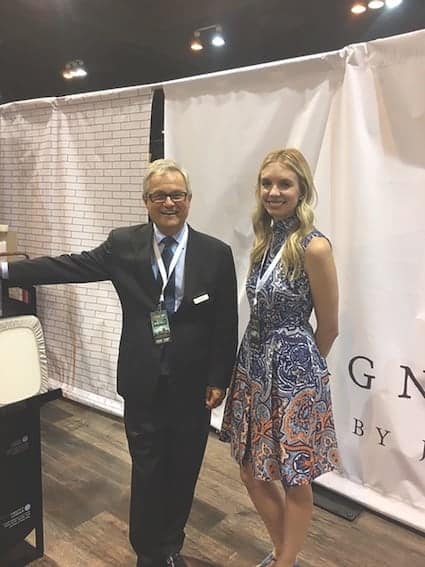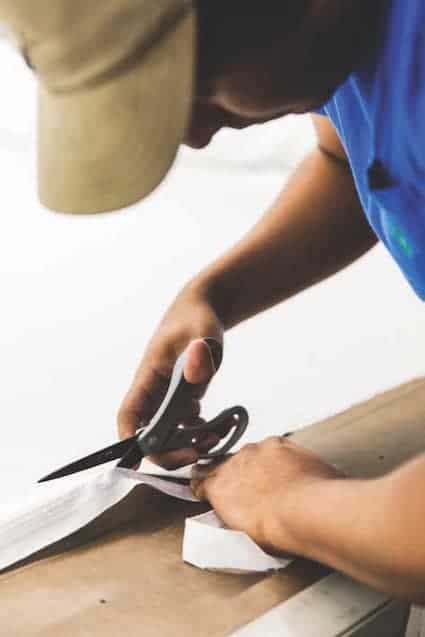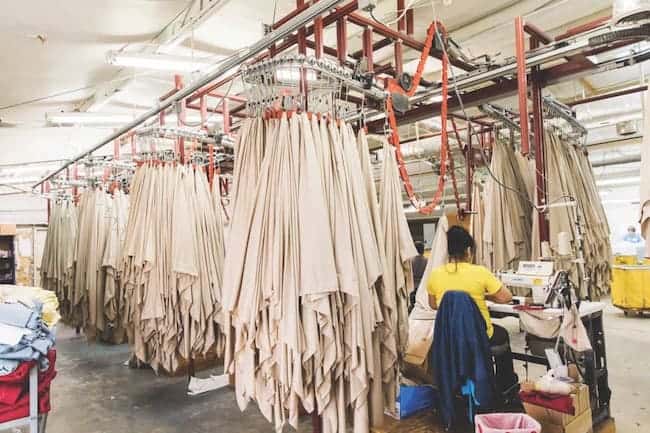Sleep accessories producer continues to innovate its products and offer new tools for retailers

DreamFit linens are made with patented elastic corner bands that HomTex says are 20 times stronger than standard elastic.
Jerry Wootten knows what it feels like to lose a dream and start over. The vivid memory of the failure of his first company provided the motivation to found HomTex Inc. in 1987 and build it into a highly successful supplier of specialty sheets and related bedding accessories. And that dark memory remains a big influence today, as he looks for creative ways to grow the business and serve customers’ needs at an age when many of his contemporaries have hung up their business suits and retired.
“No matter how much we’ve accomplished, there’s always more to be done,” says Wootten, who is chief executive officer of the company. “Staying active in business gives me something to think about and keeps my adrenaline going. I like the challenge that comes with growing a company.”
But sales success is not the only motivator. “I love making our customers and their consumers happy,” Wootten says. “We try to improve everyone’s life that we touch with our products.”
Wootten’s first business closed soon after it opened in 1982. It was a T-shirt company that quickly generated $4,000 a week in profit. Confident that he was at the beginning of something big, Wootten gave three-weeks’ notice at his 9-to-5 job in the textile industry, moved into a house in a ritzy subdivision, purchased a plant and placed a stack of orders for supplies and materials. But as quickly as his business rose, it crashed to the ground when sales shrank, and Wootten found himself on the hook for large debts he couldn’t pay.
His only choice was to sell his house, close his business and move into a tiny trailer on his wife’s parents’ property. “My secretary said, ‘Jerry, you’ve lost $100,000.’ I said, ‘How can that be? I don’t have $100,000 to my name.”
That fiasco created a “never-ending fear of going broke and failure,” Wootten says. But it also sparked a desire to reverse his fortunes and create a successful business that would last. It wasn’t long before Wootten started another venture.
“I had a few sewing machines left, which I set up in a small rental building,” Wootten says. “My dad ran into this guy who was selling fabric remnants and that led him to ask if I ever had thought about making sheets. I told him I thought that was a good idea. ‘After all, people always have to have sheets,’ I said, ‘but T-shirts are something that you can postpone or skip.’ ”
 Planting the seeds
Planting the seeds
After some trial and error, and a few visits to Walmart’s bedding department to make sure he had the right dimensions, Wootten came up with an innovative way to turn fabric remnants into quality finished linens. Soon after, he sold his first sheet sets to a hotel in Alabama. Then, while on the road in Griffin, Georgia, shopping for fabric for a bandana order from rising country star Hank Williams Jr., Wootten learned that the company he was visiting — Mouchet Corp. — also produced sheet sets from factory fabric seconds. Factory seconds are products that are lightly blemished or have other negligible imperfections in their appearance that make them unsuitable for retail sale. Wootten asked whether there might be an opportunity for him to provide Mouchet with linens and, after agreeing to lower his price, Wootten secured his big first order. To fill it, Wootten and his family members cut and sewed fabric over the course of many late nights.

Jerry Wootten, HomTex chief executive officer, founded the company in 1987.
Fast forward to today: HomTex is a global home textiles player with 1 million square feet of domestic production capacity and more than 300 employees. Each year, the company produces 1 million sheet sets, along with an assortment of other home textiles, including mattress pads, protectors and toppers; sleeping pillows; throws, blankets and top-of-bed collections; and towels.
Founded in Vinemont, Alabama, HomTex moved its headquarters to a renovated 290,000-square-foot complex in Cullman, Alabama, in late 2017. The new space enabled the company to double its cut-and-sew capacity, providing a springboard for further expansion in the United States and, in a new initiative that is in its early stages, markets in Australia, Asia and Europe. The complex also includes 100,000 square feet for distribution.
HomTex products are sold through furniture stores, specialty sleep shops and e-commerce sites. Major customers include sleep specialists such as Mattress Firm and furniture retailers such as Nebraska Furniture Mart. But the company also sells to small independents and regional chains, providing them with small-batch quantities of sheets and pillows, rather than requiring large minimum orders.
In addition to its flagship plant in Alabama, HomTex has domestic production and distribution facilities in North Carolina, South Carolina and Tennessee, as well as fully staffed sourcing offices in China and India. The company is geared to manage a vast array of fabric SKUs, and maintains a level of inventory that enables it to ship most orders to customers within five days.

Jeremy Wootten, president and chief financial officer, is one of the next generation of Woottens who is helping shape the company’s future.
“We are a hybrid manufacturer,” Wootten says. “We kept most of our production in the U.S. initially because we had to — we simply didn’t have the money to move everything offshore. But now we also bring in select products from overseas, when needed to keep up with demand or to stay competitive.”
Consumer interest in “made in the USA” works in the company’s favor, Wootten adds, “since we’ve been here making sheets with our highly skilled workforce all along.” The blended sourcing strategy also means that HomTex’s pricing is largely protected from the 25% tariffs being applied to Chinese-sourced products, he says.
DreamFit paves the way
The core of HomTex’s line — and the foundation of much of its success over the years — is DreamFit linens. “The line was originally introduced in the early 2000s, when manufacturers began coming out with much thicker mattresses,” Wootten explains. “The mattresses were immediately popular, but none of the sheets that were available then would fit or stay on properly.”
Wootten developed a line of luxury sheets and mattress protectors that were “longer, wider and thicker than standard sheets, with stronger edge bands and much deeper pockets.” The patented DreamFlex corner bands ensure that the fitted sheet “will never pop off” the corners of mattresses, regardless of size, Wootten says. And the patented FirstFit corner straps are color coded to make it easy to put sheets on the bed correctly every time.
“I created our first DreamFit sheets for a local mattress retailer in Montgomery with about 25 stores,” he recalls. “He ordered $2,500 worth, and that got us started.”

Bob Pearce, vice president of sales and marketing, joined the company in 2005 and is credited with expanding HomTex’s business with specialty retailers. Founder Jerry Wootten’s daughter, Christina Dew, is director of personnel for the company.
Prior to the launch of DreamFit, HomTex had been focused on promotional goods sold through mass merchants and, early on, HomTex came close to placing the line in Bed Bath & Beyond. But, when things didn’t work out, Wootten pursued specialty bedding stores instead. That led to orders from Select Comfort and Tempur-Pedic and eventually to an entirely new focus on higher-end goods sold through specialty sleep retailers, furniture stores and, most recently, e-commerce sites.
As the specialty retail side of the business grew, HomTex expanded its management team in 2005 by hiring Bob Pearce, vice president of sales and marketing. Pearce “did a fantastic job of expanding our relationships with the specialty retail community,” Wootten says. “He pioneered the idea of selling better quality sheets in mattress stores at a time when the only accessories they sold were protectors, and those were items to give away, not sell.”
Today, Pearce says, savvy retailers understand that sleep accessories can be a core profit center capable of generating strong sales and shopper traffic.
“We know that around 75% of consumers will purchase new sheets within minutes, hours or days of a new mattress purchase,” Pearce says. “Ideally, retail sales associates redirect customers to make top-of-bed selections before they leave the store. Offering a system of quality sleep solutions is good for the retailer’s business, and it’s good for the new mattress owner.”
Accessories also are a great tool for stores to build customer loyalty, as consumers make return visits between mattress purchases to pick up additional sheet sets and other products for their beds or to give as gifts. “When they become advocates for the DreamFit innovation and brand, they are your external sales force, sending friends, relatives and neighbors into your store,” Pearce says.
To educate RSAs about how to best present and sell its products, HomTex has developed a robust in-store sales training program. In addition, the company offers a range of in-store displays designed to engage consumers. At the Summer Las Vegas Market, it debuted an interactive display that combines high-impact visuals with messages about key product features and benefits.
“It’s a ‘silent salesperson’ that’s both entertaining and informative,” Pearce says. “It features a lively PowerPoint-type presentation packaged in an attractive, compact display.”
New cross-merchandising concept
At the summer market, HomTex also introduced a new concept in which its pillows, protectors and sheets are merchandised together as a single purchase. Products are grouped into three collections according to their dry, cool or dry-cool features to make it simpler for consumers to find the products best suited to their sleeping preferences.
“Rather than making three separate sales, this new approach enables the RSA to present a system approach to accessories that works together to satisfy the sleeper’s exact needs,” Pearce says. “They’re selling a complete system of cooling and drying that enhances the sleep experience and adds value to the mattress the guest has just purchased.”

HomTex’s original manufacturing facility was in Vinemont, Alabama. In 2017, the company moved its headquarters to Cullman, Alabama, but still uses the Vinemont site for some operations related to its newly acquired Southern Proper clothing line.
Within each of its product categories, HomTex offers a wide range of price points and styles. In linens, the company makes seven collections. Retail prices start at $59 for a brushed microfiber set in queen size and top out at $370 for a premium DreamFit Degree 6 set in Supima cotton and micro-Tencel. The patented Degree 6 collection, introduced in 2017, consists of a fitted sheet, a quilted top sheet and two pillow shams that are quilted on one side for fashion and flat on the other side for function.
The DreamFit Degree 6 set has several advantages over traditional bedding products, Wootten says. The temperature-regulating micro-Tencel releases excess moisture, creating a dry and healthy sleeping environment, and the U.S.-grown Supima cotton ensures that the fabric is comfortable and durable.
“DreamFit Degree 6 is very popular, followed by our bamboo (rayon) blend collection at $189 for a queen, which is one of our best-sellers,” Pearce says. But at the same time, the promotional end of HomTex’s business also is strong. “There is an amazing parity in terms of unit sales across our entire line — each product has its own unique features and benefits,” he says.
In addition to helping to boost revenue, encouraging consumers to buy protectors and other accessories along with their new mattress reduces retailers’ “bounce rates,” Pearce says. “Having the wrong sheets or protector on a mattress can add to a consumer’s dissatisfaction with a new sleep surface,” he says. “Our data shows that having the right combination of accessories on a bed reduces returns.”
Whether shopping in-store or online, today’s consumers are looking for “the same things: real solutions to problems,” Wootten says. “They want to buy products they can trust from retailers they can trust, and they want to know that they are getting value from their purchase.”
To help its retail partners cut through the clutter of messages that bombard shoppers every day, HomTex is always on the lookout for new tools and ideas to educate and motivate consumers. Like the new interactive display the company rolled out in Las Vegas, the latest generation of merchandising tools needs to be simple to use, appealing to the eye and capable of telling an engaging story.
Digital outreach
In the second half of this year, HomTex will debut a new corporate website with a host of added features. The site will provide more detailed information about its products and brands, with an updated design and content that is similar to a separate microsite it has created for its DreamFit brand.
The DreamFit site includes a dealer locator and reviews, as well as videos. One popular video on the site shows how the DreamFit fitted sheet is so strong that consumers can lift up an entire mattress by pulling on the sheet’s corners.
HomTex’s two websites and related social media efforts are designed to build awareness and demand for its retailers.
“Our goal is to support our retailers and help them realize the full potential of the sleep accessories category,” Pearce says. “Right now, our average sales ticket online is $200. Our average sale in a brick-and-mortar environment is even higher. With the right program, retailers can make a lot of money selling sheets. And they can do this anywhere in the country, not just in the big cities like New York or Atlanta.”
New venture

The cut-and-sew skills of HomTex’s U.S. workforce continue to be a bedrock of the company’s success. After the company moved its headquarters to a 290,000-square-foot complex in Cullman, Alabama, in 2017, it doubled its cut-and-sew capacity.
Always on the lookout for fresh ideas and opportunities, Wootten expanded his company’s presence into a new arena this year with the addition of Southern Proper. Based in Atlanta, Southern Proper is a Southern-inspired line of stylish clothing for men. HomTex acquired Southern Proper in January from founder Emmie Howard, who continues to lead the brand. Howard also serves as vice president of marketing for HomTex.
“We have been making products for 30 years that make people’s lives better,” Wootten says. “With our products, consumers sleep better, feel better and now they can dress better, too.”
Wootten says HomTex is developing a new Southern Proper-branded line of sleep products for introduction in early 2020.
“We see some interesting synergies between our companies,” Wootten says. “Up until now, they’ve mostly been importing, so the first step we plan to take is to bring some of that clothing production in-house.”

“A lot of our competitors have taken their cut-and-sew operations overseas but we’re committed to doing as much as we can here,” Wootten says. “To be successful, we need to attract and retain great people, so we’re looking to make our plant environments as efficient and ergonomic as possible.”
Going forward, Wootten says his company also will continue to seek new ways to innovate and meet emerging market needs. HomTex already has a dozen or so patents on its products, and Wootten expects more innovations in the future. Helping to steer the company toward that goal will be his oldest son, Jeremy Wootten, who serves as president and chief financial officer; his daughter, Christina Dew, director of personnel; and younger son, Zach Wootten, director of logistics. The company also has a talented team of product developers, marketers and other key personnel, Wootten says.
“We really are one big family,” Pearce says about the company’s culture. “We all take a great deal of pride in our work, and we all work very hard because, at the end of the day, we’re all dedicated to making quality products that last and help our customers live better lives.”




 Planting the seeds
Planting the seeds